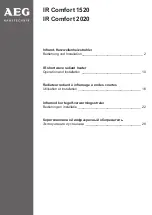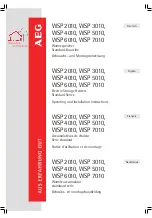
9
10
About Pressure Cooking
Pressure cooking is an ideal way to make fast, tasty meals for your
family! This method of cooking makes it easy for even the busiest cooks
to prepare meals from scratch. Use your pressure cooker for fish,
chicken, fresh vegetables, rice, legumes, and even dessert – and
everything can be cooked to perfection in minutes. The pressure cooker
will save you time, energy and money, as well as valuable nutrients.
Boiling liquid inside the tightly sealed pot produces steam, which is
trapped inside to create pressure. The very hot temperature produced
reduces cooking time. The steam helps break down the fibers of
whatever you’re cooking and infuse the food with flavors. This also
captures all of the water-soluble nutrients, making the food higher in
flavor and more nutritious than with conventional cooking methods.
Additional Safety Tips
•
Always keep hands and face away from Pressure Release Device
when reducing pressure.
•
Use extreme caution when removing lid after cooking.
Always tilt the lid away from you, so any remaining steam is blocked
from your face.
•
Never attempt to open lid while cooking, or before pressure
indicator has dropped. Do not attempt to defeat this safety
feature by forcing it.
•
Do not cover or block the pressure valves.
•
Do not touch the pot or lid except for the handle immediately
after using.
•
To avoid burns, allow food to cool before tasting.
The temperature of the food gets considerably hotter than
with conventional cooking.
Using Your Pressure Cooker
1
Gather all ingredients and be familiar with your recipe. Pour required
amount of liquid into removable cooking pot, then add food. Use the
cooking rack, if desired.
Except when cooking rice, never load cooker
above the maximum ingredient level line marked “2/3 MAX PC” on
cooking pot. Foods that expand while cooking (i.e. legumes) should
never go above the 3/5 mark.
See instructions for cooking rice on
page 11.
2
Make sure gasket is securely positioned in the inner lid. Always
examine the gasket before installing and before each use. Make sure
it is in good working order and free of any tears.
3
Secure lid on pressure cooker by grasping the handle and twisting
clockwise to lock in place.
4
Set the Pressure Release Device to the SEAL position. (See Figure 1).
5
Plug power cord into unit first and then into a 120-volt 60 Hz AC
only outlet.
6
Press the round ON/OFF button once. The display will flash.
7
Press the FUNCTION button until desired cooking function is
displayed. The pressure cooker will begin to heat and reach pressure.
The HEAT light will illuminate. Once pressure has been achieved,
pressure will automatically be maintained. Cooking time begins at
this point, and the time will begin counting down in the display.
8
After pressure cooking is complete, pressure can be released
manually or on its own. If a recipe states "let pressure drop on
its own," press the ON/OFF button and unplug the cooker. When
recipe states "reduce pressure at once" or “reduce pressure
manually”, turn the Pressure Release Device to the VENT position to
release steam and reduce pressure. (See Figure 2). Use caution
when manually releasing pressure as hot steam will be released.
It is not recommended to release steam manually with recipes
containing lots of liquid, such as soups and stews.
9
Pressure is completely reduced when the Steam Release Dial is in
the Vent position, (see Figure 2) and you no longer hear steam
escaping from the valve, and the lid opens freely with no force. Only
then is it safe to remove pressure cooker lid and serve food. Remove
lid by grasping the handle and twisting lid counter-clockwise. As a
safety feature, the lid will not open unless all pressure is reduced. DO
NOR forrce the lid open if it does not open freely, this means that
the unit is still under pressure.
Figure 1
Figure 2
TSCDIST_PressureCooker manual 7/20/07 11:29 AM Page 9







































